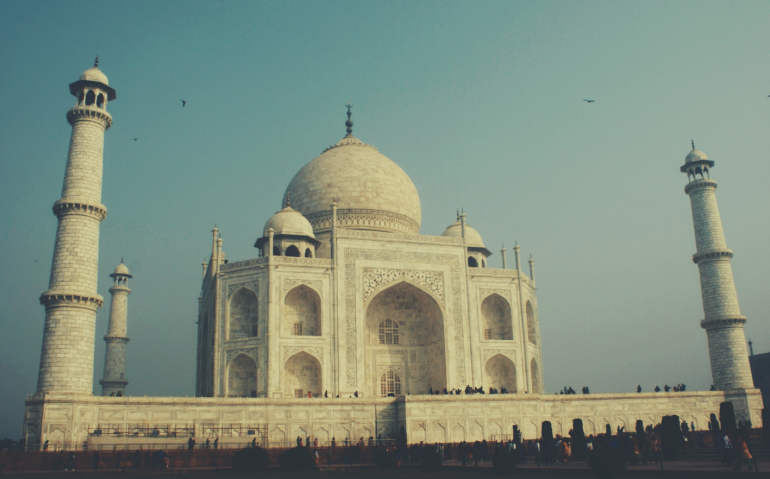People who lack perspective see it as a palace. People who appreciate the grandeur see it as one of the seven wonders of the world. But to the many who know the history, not by mind but by heart, the Taj Mahal is a legacy of eternal love—a love story set not in paper, but in marble. A mausoleum of a Mughal empress and her emperor. With written and documented history on the building and the empire it belonged to, it is perplexing that some still argue the ownership of the Taj Mahal, and deny the fact that it is a tomb belonging to the Mughal Empire. If one studies the history of this great empire, one can easy tell fact from fiction.
The layperson definition of the Taj Mahal: the world’s most famous tomb. To better understand this definition, it is imperative that some information be stated about the Mughal Empire. According to an article by the BBC in a series feature on the Mughal, the founder of the empire, Babur, was originally a descendant of Genghis Khan and Tamerlane. He was the first of many emperors to rule the Indian subcontinent, from 1526 to 1761. Until its fall, the empire was an efficiently organized empire, with huge amounts of wealth and military power. The Mughals were responsible for spreading Islam in Southeast Asia. They were Muslims ruling a country with a Hindu majority, and until the British took over, the presence of Islam was strong. The Mughal Empire also built the Taj Mahal.
Shah Jahan, which is Persian for “King of the World,” was the fifth emperor of the Mughal Empire. During his reign, he constructed the Taj Mahal for his beloved wife, Mumtaz Mahal, whose name means “The Exalted One of the Palace.” Of all the wives, she was Shah Jahan’s favorite, and when she passed away during childbirth in 1631, he was heartbroken. She died while Shah Jahan was in battle, and therefore he had her buried temporarily in Burhanpur. He would visit the grave every Friday, and recite the first verse of the Quran, for as long as the army was stationed there. The love was so great that he disregarded all the guidelines of Islamic burial and had the body taken out, and bought to Agra, near the bank of the river Yamuna. Her body was brought to the construction site of the Taj Mahal, which Shah Jahan had chosen. In the book, Taj Mahal, by Giles Tillotson, he writes about how the burial site was owned by the Raja of Amber, who was compensated by properties in the city. The tomb’s construction, over her grave, took twelve years. Tillotson provides an excellent example of symbolism and love when he writes, “the time, the effort, the cost and the splendid result have all been taken as further evidence of the power of Shah Jahan’s grief.”
Symbolism is what the Taj Mahal is all about. Little is known about the architects of this great building, mostly because during the emperor’s reign, he liked his buildings, forts, and palaces to be built to a specific standard. He liked to pay homage to his past ancestors, and favored the old Mughal tombs and forts. All the prior mausoleums were grand, and the Taj combines elements borrowed from all of them, united in perfect harmony. His intention was to build paradise on earth, and many of its symbolic stylings resonate with the empress, or her likings.
There are three gates to enter the complex. The main one is the one facing the Taj Mahal directly. National Geographic notes that this gate is a brilliant example of optical illusion. When using the main gate as a frame, the Taj Mahal appears smaller the closer you walk towards it, but larger as you walk away from it. I have experienced this myself, and to actually witness this illusion is mind bending. I couldn’t find any recorded fact about why this design aspect was chosen, but many historians and even architects conclude that it adds to the poetry of the building; when you leave the Taj, it appears to get bigger and bigger through the gate, and hence the local saying is that when you leave, you take this love story with you.
According to Koch, the Taj is the architectural embodiment between this life and the next. The entire complex is symmetrical on both axes. One axis proves Koch’s point, where one half is the Taj and its gardens symbolizing heaven, and on the other half is a bazaar and servant’s quarters, symbolizing life on earth. The color code of the building is also symbolic. The mausoleum was meant to be a heavenly building, beaming with enlightenment, and therefore the special ivory white marble, portraying the soul of the empress, was reserved by the emperor. The emperor became so obsessed and focused with the mausoleum, that there was famine in other parts of the empire. He ordered much of the empire’s grain and supplies to be diverted to Agra, where the Taj was being built. Mughal courts and writers documented that artists from all over the empire were summoned to Agra. Just as a poet uses his words to write, that specific marble was the architect’s words.
I believe that the marble was chosen to give it a floating illusion, because upon my first glance of the building, my mind understood that the building is immense in size, but it appears to be light and floating. The gardens and water features are what catches the viewer’s attention after the building. It pays tribute to the heavenly gardens described in the Quran. The water channels that run across the garden represent the rivers of paradise. “And give good tidings to those who believe and do righteous deeds that they will have gardens [in Paradise] beneath which rivers flow” [Quran 2: 25]. The concept of the garden with four streams before the mausoleum was to make visitors feel like they are entering paradise. Like all the other Mughal mausoleums, the presence of Islam is undeniable.
To understand the theories and articles about the Taj being a temple to a Hindu goddess, it is important to acknowledge that India’s majority practices Hinduism, making Islam a minority. So the mass population of this country reacts in a different way to the Mughals and all their buildings. The prime minister of India, Narendra Modi, compared the Mughal Kings to British rulers and labeled the Mughal empire a period of slavery. According to an article in The Guardian, Vishal Sharma, the secretary of the Agra Tourist Welfare Chamber said, “they [Hindu nationalists] have a certain attitude towards any buildings that were built by Muslim rulers,” in response to Modi’s comment. A chief minister named Yogi Adityanath approved a tourism brochure omitting any mention of the Taj, but listing Hindu pilgrimage locations including the temple in eastern Uttar Pradesh, where Adityanath serves as head priest. He went on in length stating, “Taj Mahal should have no place in Indian history,” claiming Shah Jahan, the emperor who built the mausoleum for his deceased wife, had “wanted to wipe out Hindus.” Despite documented evidence from European scholars, architects, and historians, Indian writer P.N. Oak argues that the Taj is a Shiva temple; P.N. Oak has also claimed Westminster Abbey is a Shiva Temple. This sort of intentional tampering of recorded history is an example of religious tensions against the Mughal Empire and Muslims in India. A country where the majority feels this way creates a difficult scenario in preserving world heritage sites. It is indeed sad that a wonder of the world is being used as a point of contention between Hindus and Muslims.
Tensions between the two religions in India are evident. I have been touring India since 2004, and with every visit I made, I saw something the Mughals left behind. Over the years, I have witnessed with each restoration that Arabic scriptures, engraved into the buildings and tombs, start disappearing. If it were not for the Aga Khan Foundation, which has taken over funding for these Mughal sites, a lot of vital components would have been lost. UNESCO also plays a significant part in the preservation of these magnificent buildings. The Taj Mahal is recognized on the UNESCO World Heritage Site as the “the jewel of Muslim art in India and one of the universally admired masterpieces of the world’s heritage.” This provides the Taj’s immutability over any dispute. Once selected by The United Nation, the site is legally protected by international treaties.
However, not all pitchforks in India are sharpened toward the Taj. Many Indian historians are disturbed by all the needless controversy, terming it “absolutely wrong and absurd.” The Taj Mahal’s history is in fact not vague, or suspicious. On the contrary, it is among the best chronicled of any Indian monument, recorded in detail at the time by three court historians. Leading historian R. Nath also confirms the fact that Shah Jahan purchased the land. There are documents that prove the foundation of the grave and the building. He also made it clear by saying, “There is not a single piece of evidence to support this theory that it was a Shiva temple.” To further cement his statements, another historian named Rana Safvi actually possesses a copy of the original property deed, which the emperor used to obtain land for the Taj Mahal. Savi argues against Modi’s statement about the Mughal Empire being a slave driven empire, saying, “There is a lot of difference between colonists such as the British and rulers like the Mughals, who lived in India, married in India, and died in India.” Unfortunately, people like these historians are not in charge, and, sadly, events like the banning of Muslims from praying in the mosques of the Taj Mahal are widely suggested and encouraged.
The beauty of the Taj, its story, and all this controversy will never make sense until one has been to the Taj Mahal and stepped on the marble stones. The connection remains incomplete if you don’t touch the water that plays with the water from the Yamuna River. You have to be there, read the scriptures, and listen to the tour guides telling you all these wonderful tales of their own, so beautifully constructed that it makes you wonder if Shah Jahan was actually real. The most beautiful and symbolic piece of the Taj is not within its grounds, but on the opposite banks. The emperor’s architect was so involved in symbolizing the love Shah Jahan had for his beloved, he wanted to create a black marble foundation, with no building on it. According to Koch, and many experts on the Taj Mahal, the architect’s purpose was to reflect the building using the calm Yamuna River, on the black marble, to create a mirror image of a Taj Mahal that was black. This would complete the tribute to the empress’s memory for eternity, in light and in darkness! Unfortunately, that was never completed and the symbolism stops with the Taj Mahal only. Nevertheless, I believe that the famous poet Tagore encapsulates the symbolism of the wonder of the world when he wrote, “Let the splendor of diamond, pearl, and ruby vanish like the magic shimmer of the rainbow. Only let this one tear-drop, this Tajmahal [sic], glisten spotlessly bright on the cheek of time, forever and ever.”





